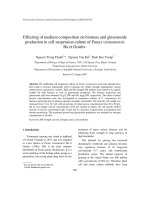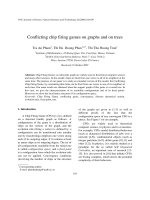Tài liệu Báo cáo " Conflicting chip firing games on graphs and on trees " pptx
Bạn đang xem bản rút gọn của tài liệu. Xem và tải ngay bản đầy đủ của tài liệu tại đây (194.76 KB, 7 trang )
VNU Journal of Science, Natural Sciences and Technology 24 (2008) 103-109
103
Conflicting chip firing games on graphs and on trees
Tra An Pham
1
, Thi Ha Duong Phan
1,2,*
, Thi Thu Huong Tran
1
1
Institute of Mathematics, 18 Hoang Quoc Viet, Cau Giay, Hanoi, Vietnam
2
LIAFA Université Denis Diderot, Paris 7 -Case 7014-2,
Place Jussieu-75256, Paris Cedex 05-France
Received 31 October 2007
Abstract. Chip Firing Games on (directed) graph are widely used in theoretical computer science
and many other sciences. In this model, chips are fired from one vertex to all of its neighbors at the
same time. The purpose of our paper is to study an extended version of this model, the Conflicting
Chip Firing Game, by considering that chips can be fired from one vertex to one of its neighbors at
each time. Our main results are obtained when the support graph of this game is a rooted tree. In
this case, we give the characterization of its reachable configurations and of its fixed points.
Moreover we show the local lattice structure of its configuration space.
Keywords: Chip Firing Game, conflicting game, convergence, discrete dynamical system,
evolution rule, fixed point, tree.
1. Introduction
*
A Chip Firing Game (CFG) [1,2] is defined
on a directed (multi) graph as follows. A
configuration of the game is a distribution of
chips on the vertices of the graph, and the
evolution rule (firing a vertex) is defined by: a
configuration can be transformed into another
one by transferringa chipfrom one vertex along
each of its outgoing edges, if it contains at least
as many chips as its outgoing degree. The set of
all configurations reachable from the initial one
is called configuration space, and a fixed point
is a configuration from which the evolution rule
can not be applied. Convergence conditions
(involving the number of chips or the structure
_______
*
Corresponding author.
E-mail:
of the graph) are given in [1-3] as well as
different proofs of the fact that the
configuration space of any convergent CFG is a
lattice. See Figure 1 for an example.
CFGs are widely used in theoretical
computer science, in physics and in economics.
For example, CFGs model distributed behaviors
(such as dynamical distribution of jobs over a
network [4,5]), combinatorial objects (such as
integer partitions [6-9], dollar game [10,11] and
other [12]). In physics, it is mainly studied as a
paradigm for the so called Self Organized
Criticality, an important area of research [13-
15]. It is also proved in [16] that infinite CFGs
are Turing complete, which shows the potential
complexity of their behaviors.
Tra An Pham et al. / VNU Journal of Science, Natural Sciences and Technology 24 (2008) 103-109
104
Fig. 1. The configuration space of a CFG with 9 chips. The weight of each vertex is indicated, and the shaded
vertices are the ones which can be fired.
We observe that in CFGs, the condition for
firing a vertex is quite strict: this vertex must
contain at least as many chips as its outgoing
degree. However, in many model, for example
models in distributed systems [5] or in
economics [11], chips can be fired from a
vertex to one of its neighbors if this vertex has
at least one chip. And in this case, chips are not
transferring to all neighbors of this vertex at the
same time, but at different times. In order to
modelize these systems, we investigate an
extended version of CFG, by considering that a
configuration can be transformed into another
one by transferring chips from one vertex along
one of its outgoing edges. However, the firing
of a chip along one edge may cause a conflict
with the one along another edge. Hence we call
our model “Conflicting Chip Firing Game”
(CCFG).
Further, we constate that, in this new
model, by relaxing the condition about the
number of chips in a vertex, the evolution rule
is much more flexible. In other side, the
obtained configuration space has not the lattice
structure, and the convergence properties. This
situation is illustrated at the end of Section 2.
Moreover, we note that it is more difficult to
find a support graph which has good properties
in CCFG model than in CFG model.
In Section 3, we consider a particular but
important case of CCFGs, where the support
graph is a rooted tree. We characterize the
reachable configurations and fixed points of the
model. At the end, we study the complexity as
well as the local lattice structure of the
configuration space.
Before entering in the core of this paper,
letus give here some preliminary notations of
order and lattice theory. A binary relation ≤
over a set P is said to be an order if it is
reflexive, transitive and anti-symmetric. The set
P together with the relation ≤ is then called a
partially ordered set, or simply a poset. A poset
L is a lattice if any two elements x and y of L
have a greatest lower bound, called the infimum
of x and y and denoted by inf(x, y), anda
smallest greater bound, called the supremum of
x and y and denoted by sup(x, y). The study of
lattices is an important part of order theory, and
many results about them exist. In particular,
various classes of lattices have been defined and
appear in computer science, mathematics,
physics, social sciences, and others. For more
details about orders and lattices, we refer to
[17].
Tra An Pham et al. / VNU Journal of Science, Natural Sciences and Technology 24 (2008) 103-109
105
2. The general model conflicting chip firing
games
In this section after giving the definition of
the model Conflicting Chip Firing Games
(CCFG), we investigate the relation between its
configurations.
Let G = (V, E, c) be a (weighted) directed
graph where V = {1,2, ,m} being the set of
vertices of G, E = {t
1
,t
2
, ,t
p
}⊂ V × V being the
set of edges of G, and the capacity function c
being a function from E to N. A CCFG on G =
(V, E, c) (G is called the support or the base of
the game) with n chips is defined as follows. A
configuration a = (a
1
, a
2
, , a
m
) of the game is a
distribution of n chips into V, where the weight
a
i
associated with each vertex i can be regarded
as the number of chips stored at the vertex i.
The evolution rule, called also transition rule or
firing rule is the following: an edge (i, j) can be
fired if the vertex i contains at least c(i, j) chips,
and the firing of this edge is the transferring of
c(i, j) chips from vertex i to vertex j. Moreover,
a firing sequence is a sequence of firings.
Let G be a support graph, and let O be a
configuration, we call configuration space, and
we denote by CCFG(G,O), the set of all
configurations reachable from the initial
configuration O. On this set, we define the
following relation: a
≥
b if b can be obtained
from a by applying a sequence of firings.
In order to describe the evolution of a
CCFG on graph G, we introduce the evolution
matrix M(G) as follows: M(G) = (a
qi
)
p x m
where
a
qi
= c(t
q
) (resp. a
qi
= -c(t
q
)) if i is the going out
(resp. going in) vertex of edge t
q
, and a
qi
= 0
otherwise. Denote by e[q] the unit p-parts
vector, where the position q is equal to 1, and
the others are equal to 0. We constate that if
configuration b is obtained from configuration a
by firing edge t
q
then b = a+ e[q] × M. Further,
let
(
)
r
ii
ttC , ,
1
= be a firing sequence from a
to b where the edges
q
ii
tt , ,
1
are subsequently
fired. We define the shot vector of C being the
vector k(C) = (k
1
, ,k
p
) where k
q
is the number
of occurrences of t
q
in C. The following result is
direct from the above definitions:
Proposition 1: Let C be a firing sequence
from a to b, then we have: b= a+ k(C)
×
M(G).
Let us give in Figure 2 a small example of
this game. From this figure, we see that
configuration (1, 2, 6) is obtained from (3, 4, 2)
by the sequence C = t
1
t
2
t
3
t
4
t
1
t
2
t
3
t
4
. So the shot
vector of C is (2, 2, 2, 2).
Moreover, from this small example, we can
observe that in constrat with the case of the
classical CFG, a CCFG may have cycles (firing
sequences come from a configuration and come
back to itself) and have many fixed points.
Therefore, it has not a lattice structure.
However, in some cases where the support
graph has some “good” properties, this structure
is maintained. In the next section, we study
such a particular (and important) class of
CCFG.
3. CCFG on a tree
The purpose of this section is to investigate a
class of CCFG whose the support graph is a
rooted tree with edges directed from nodes to
their children. We show a characterization for
reachable configurations and for fixed points of
this game. This allows us to describe the
complexity of the game by giving the
cardinality of its configuration space. We also
prove the local lattice structure of this space.
Tra An Pham et al. / VNU Journal of Science, Natural Sciences and Technology 24 (2008) 103-109
106
Fig. 2. Some configurations of a CCFG with 9 chips.
First of all, we present here some
preliminary definitions.
Definition 1: Let T = (V, E) be a rooted
tree with V = {1, , n}, a node is a vertex of
T, a leaf is a node having no child, and the
depth of a node v, denoted by d(v), is the
length of the unique path from the root to v.
Definition 2: Let n be a positive integer
and let S be a set with |S| = k. A composition
of n into S is an ordered sequence (a
1
, a
2
, ,
a
k
) of non negative integers such that a
1
+ a
2
+
+ a
k
= n. The integer a
i
is called the weight
of i.
Next, we define for each composition a of
n into V, the horizontal energy as follows:
Definition 3: Let T = (V, E) be a rooted
tree and let a = (a
1
, , a
m
) be a composition of
n into V. The horizontal energy e
H
(i, a) at node
i of a is the quality a
i
d(i). And the horizontal
energy of a is the quality
( )
(
)
H H
i V
e a e i,a
∈
=
∑
.
Now, the CCFG on T with n chips,
denoted by CCFG(T,n), is defined as follows:
• Each configuration is a composition of n
into V;
• In the initial configuration
O
, all n chips
are centered at the root, and there is no chip
at other nodes;
• Evolution rule: the node i can give one chip
to the node j, one of its children, if i has at
least one chip.
We denote also the configuration space of
this game by CCFG(T, n), and we write b ≤ a
if b can be obtained from a by a firing
sequence. In particular, we write a → b if b is
obtained from a by applying once evolution
rule. It is clear that e
H
(b) = e
H
(a) – 1. This
implies the following result.
Lemma 1: The configuration space
CCFG(T, n) has no cycle and consequently it
is stationary. Moreover, the set CCFG(T, n)
equipped with the relation ≤ is a poset.
Figure 3 shows an example of a CCFG on
a tree of 5 nodes with 2 chips.
In the next propositions, we give a
characterization of configurations of
CCFG(T,n) as well as its fixed points.
Tra An Pham et al. / VNU Journal of Science, Natural Sciences and Technology 24 (2008) 103-109
107
Fig. 3. The configuration space of a CCFG on tree.
Proposition 2: The set CCFG(T,n) is
exactly the set of compositions of n into V.
Consequently, CCFG(T,n) has exactly
1
1
n m
m
+ −
−
configurations.
Proof: Let a = (a
1
,a
2
, ,a
m
) be a
composition of n into V. It is clear that if e
H
(a)
= 0 then a have no chips at any node but the
root of T, that means a is nothing but
O
. In the
case e
H
(a) > 0, we prove that there exists a
firing sequence from the initial configuration
O
to a. For that, it is sufficient to show that there
exists a composition a’ of n into V such that a’
→
a and e
H
(a’) < e
H
(a). Because e
H
(a) > 0,
there exists a node i such that a
i
> 0. Let j be the
father of i. We consider the composition a’
obtained form a by increasing a
j
by 1 and by
decreasing a
i
by 1. It is easy to check that a’ is a
composition of n into V satisfying a’
→
a and
e
H
(a’) = e
H
(a) - 1.
This result implies that the number of
configurations of CCFG(T,n) is the number of
non-negative integer solutions of the equation
x
1
+ x
2
+ … + x
m
= n. Hence it is
1
1
n m
m
+ −
−
.
The proof is completed.
Then the following result is straightforward:
Corollary 1: The fixed points of CCFG(T,n)
are compositions of n into the set of leaves of T.
Consequently, the number of fixed points of
CCFG (T,n) is
1
1
n l
l
+ −
−
, where l is the number
of leaves of T.
In the previous section, while studying the
general model CCFG, we show a necessary
condition by shot vector for two configurations
to be comparable. However, we have not yet
given any sufficient condition for this. In
constrat, withthe support graph beinga tree, we
can describe explicitely the order between
configurations by introducing the following
notation of vertical energy.
Definition 4: Let T = (V, E) be a rooted tree
and let a = (a
1
, ,a
m
) be a composition of n into
V. The vertical energy e
V
(i,a) at node i of a is
equal to the number of chips in the subtree of T
Tra An Pham et al. / VNU Journal of Science, Natural Sciences and Technology 24 (2008) 103-109
108
rooted at i. And the vertical energy of a is the
quality
(
)
(
)
V V
i V
e a e i,a
∈
=
∑
.
We observe that e
V
(a) = e
H
(a). Moreover, if
the node i has children i
1
, i
2
, ,i
k
then e
V
(i,a)=
e
V
(i
1
, a) + e
V
(i
2
, a) + … + e
V
(i
k
, a) + a
i
.
Therefore, each configuration is determined
uniquely by their vertical energies at all nodes
of the support tree.
We can now state our result on the order of
CCFG on tree:
Theorem 1: Let a and b be two
configurations of CCFG(T, n). Then a
≥
b in
CCFG(T, n) if and only if e
V
(i, a)
≤
e
V
(i, b) for
all nodes i of T.
Proof: First, we prove the necessary
condition. It is sufficient to prove the statement
for the case a
→
b. Assume that b is obtained a
by transferring one chip from node i to j. Then
a
l
= b
l
for all l ≠ i, j. Let k be a node of T. If k ≠
j, then the subtree of T rooted at k contains
either both i, j or none of them. So e
V
(k, a) =
e
V
(k, b). If k = j, then e
V
(j, a) = e
V
(j, b)- 1.
Therefore, e
V
(k, a) ≤ e
V
(k, b) for all nodes k
of T.
Conversely, we prove the sufficient
condition for showing that there exists a firing
sequence from a to b. It is clear that if e
V
(i, a) =
e
V
(i, b) for all nodes i then a = b. For other
cases, we remark that there exists a node i such
that e
V
(i, a) < e
V
(i, b) and e
V
(k, a) = e
V
(k, b) for
all nodes tk of the subtree rooted at t. This
implies that a
i
< b
i
. Let j be the father of i. Let c
be the composition of n into V obtained from b
by increasing b
j
by 1 and by decreasing b
i
by 1.
It is easy to see that c
→
b. So, by using the
necessary condition, we have e
V
(i, c) = e
V
(i, b)
– 1 and e
V
(k, c)= e
V
(k, b) for all nodes k ≠ i.
Hence, e
V
(k, c)
≥
e
V
(k, a) for all nodes k of T. So
by recurrence we also obtain an inverse firing
sequence from b back to a. This completes the
proof.
To finish this section, we investigate the
structure of CCFG on tree. Let us recall that, in
the classical model CFG, the configuration
space has a lattice structure with a unique fixed
point. Unfortunately, in the general CCFG,
there are many fixed points in the configuration
space and the structure of this space is quite
complicate. Nervertheless, in the case the
support of a CCFG is a rooted tree, we can
prove the local lattice structure. Let us first
recall that for any two elements a
≥
b in a poset,
the interval [b,a] is the set of all elements c
suchthat a ≤ c ≤ b.
Theorem 2: Let a ≥ b be two configurations
of CCFG(T,n). Then the interval [b,a] is a
graded lattice.
Proof: Since the interval [b,a] has a mimimal
element b, to prove its lattice structure it is
sufficient to prove that for any two elements c,d
∈ [b,a], there exists sup(c,d) (see [17]). To find
this supremum, we first compute its vertical
energies as follows. Put e
i
= min{e
V
(i,c),
e
V
(i,d)} for every node i of V. It is clear that e
1
=
n. In addition, if i has children i
1
, i
2
, ,i
k
, then
k
iii
eee +++
21
(
)
(
)
{
}
(
)
(
)
{
}
dikeciediecie
VkVtVtV
,,,min ,,,min ++=
(
)
(
)
(
)
(
)
{
}
diedieciecie
kVVkVV
, ,,, ,min
11
++++≤
(
)
(
)
{
}
iVV
ediecie =≤ ,,,min .
Now, let us define the following sequence
of non-negative integers: g = (g
1
,g
2
, ,g
m
)
where
(
)
k
iiiii
ggggg +++−=
21
. It is
clear that this sequence is a composition of n
into V, that means g is a configuration of T.
Furthermore, g has vertical energies e
1
, e
2
, ,
e
m
. So by using Theorem 1, we have g ≥ c and g
≥ d. On the other hand, let h be a configuration
of CCFG(T,n) satisfying h ≥ c,d. We have e
V
(i,
h)
≤
e
V
(i, c) and e
V
(i, h) ≤ e
V
(i, d) for all nodes i
of T, this implies that e
V
(i, h) ≤
Tra An Pham et al. / VNU Journal of Science, Natural Sciences and Technology 24 (2008) 103-109
109
min{e
V
(i,c),e
V
(i,d)}= e
V
(i,g). Hence g
≤
h. This
proves that g is the supremum of c and d.
Finally, we remark that the horizontal
energy is reduced by exactly 1after once
applying the evolution rule. So the lattice [b,a]
is graded.
The following corollary is straightforward
from the graded propertyn of the lattice.
Corollary 2: In the CCFG(T,n) we have:
i) The maximal length of a firing sequence from
the initial configuration to one fixed point is
{
}
)(max. idn
Ti∈
.
ii) The minimal length of a firing sequence
from the initial configuration to one fixed point
is
{
}
)(min. idn
Ti∈
.
References
[1] A. Bjorner, L. Lov´asz, W. Shor, “Chip-firing games
on graphes”, E.J. Combinatorics 12 (1991) 283.
[2] A. Bjorner, L. Lov´asz. “Chip firing games on
directed graphes”, Journal of Algebraic
Combinatorics 1 (1992) 305.
[3] M. Latapy, H.D. Phan, “The lattice structure of chip
firing games”, Physica D 115 (2001) 69.
[4] S T. Huang, “Leader election in uniform rings”,
ACM Trans, Programming Languages Systems 15 (3)
(1993) 563.
[5] J. Desel, E. Kindler, T. Vesper, R. Walter, “A
simplified proof for the self-stabilizing protocol: A
game of cards”. Information Processing Letters 54
(1995) 327.
[6] E. Goles, M.A. Kiwi, “Games on line graphes and
sand piles”, Theoret. Comput. Sci., 115 (1993) 321.
[7] E. Goles, M. Latapy, C. Magnien, M. Morvan, H.D.
Phan, “Sandpile models and lattices: a
comprehensive survey”, Theoret. Comput. Sci., 2001.
To appear.
[8] E. Goles, M. Morvan, H.D. Phan, “The structure of
linear chip firing game and related models”, Theoret.
Comput. Sci., 270 (2002) 827.
[9] C. Magnien, H.D. Phan, L. Vuillon, “An extension of
the model of chip firing game”, Discrete Math.
Theoret. Comput. Sci., AA (2001) 229.
[10] N. Biggs, “Algebraic potential theory on graphs”,
Bull. London math. Soc., 29 (1997) 641.
[11] N. Biggs, “Chip firing and the critical group on a
graph”, Journal of Algebraic Combinatorics 9 (1999)
25.
[12] D. Rossin, R. Cori, “On the sandpile group of dual
graphs”, European Journal of Combinatorics 21
(2000) 447.
[13] P. Bak, C. Tang, K. Wiesenfeld, “Self-
organizedcriticality: An explanation of 1/f noise”,
Physics Review Latters 59 (1987) 381.
[14] M. Latapy, R. Mataci, M. Morvan, H.D. Phan,
“Structure of some sand piles model”, Theoret.
Comput. Sci., 262 (2001) 525.
[15] C. Moore, M. Nilsson, “The computational
complexity of sand piles”, Journal of Statistical
Physics 96 (1999) 205.
[16] E. Goles, M. Margenstern, “Universality of chip
firing game”, Theoretical Computer Science, 172
(1997) 121.
[17] B.A. Daveyand H.A. Priestley, “Introduction to
Lattices and Order”, Cambridge UniversityPress,
1990.









